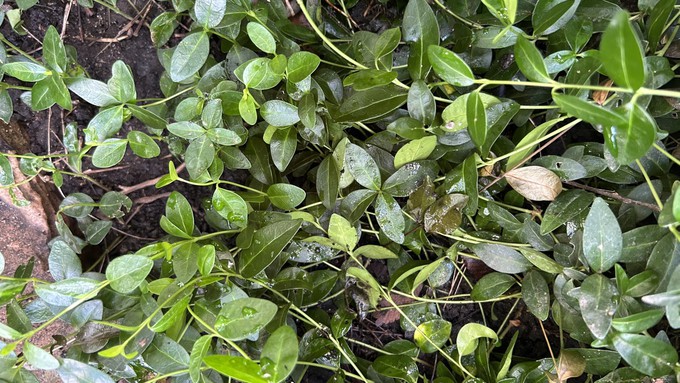
Raising awareness of these plants is a statewide effort

No flowers on it at the moment, but the matting tendency of Vinca major is obvious. Kathy Morrison
California gardeners with any experience likely have planted something that they've lived to regret. The tree that throws up suckers, the flowers that reseed too fully, the shrub that grows into a sticky, smelly mess. But at least these are confined disasters, which could be (probably should be) "shovel pruned."
The really dangerous plants are ones so vigorous that they can spread from gardens into open landscapes, pushing out native plants and causing ecological damage.
The worst of these infamous species are on a Do Not Plant List. They include such disasters as pampas grass, water hyacinth and highway iceplant. These botanical thugs are receiving some extra attention during California Invasive Species Week, which runs through Sunday.
PlantRight.Org, the California Invasive Plant Council (Cal-IPC) and the California Native Plant Society have pushed hard to persuade nurseries to stop selling these plants to landscapers and home gardeners. Officially, 15 of them are "retired," each one a victory for the state's ecosystem, but that doesn't mean these plants aren't still out there: Scotch broom and blue gum eucalyptus, for example, are still evident around California -- and add to fire fuel loads, meaning they're dangerous near homes.
Check out the PlantRight current list as well as the retirees. The list includes alternatives to plant that resemble the thugs but are either native or much better behaved.
Meanwhile, I'm going to work harder to get rid of that periwinkle (Vinca major, not the cultivars), which some previous resident planted in my back garden. Such a pretty little plant, but really nasty when it gets near streams, apparently. Here's what PlantRight says:
"Because periwinkle grows rampant in many California backyards, new populations of this plant also commonly spread from locations where yard waste is dumped."
And this: eek! "Periwinkle is a fast-growing, competitive plant that forms dense mats of growth. These mats crowd out other plants and degrade animal habitat in infested areas. Riparian areas are especially susceptible to periwinkle, where the far-flung vines crowd out native vegetation. It is also a known host to the bacterium that causes Pierce's disease, which is a deadly disease to grapevines."
Oh, yeah, it's gotta go.
Comments
0 comments have been posted.Sacramento Digs Gardening to your inbox.
Sites We Like
Garden Checklist for week of May 12
Get your gardening chores and irrigation done early in the day before temperatures rise.
* Plant, plant, plant! It’s prime planting season in the Sacramento area. Time to set out those tomato transplants along with peppers and eggplants. Pinch off any flowers on new transplants to make them concentrate on establishing roots instead of setting premature fruit.
* Direct-seed melons, cucumbers, summer squash, corn, radishes, pumpkins and annual herbs such as basil.
* Harvest cabbage, lettuce, peas and green onions. This heat will cause leafy greens and onions to flower; pick them before they bolt.
* In the flower garden, direct-seed sunflowers, cosmos, salvia, zinnias, marigolds, celosia and asters.
* Plant dahlia tubers. Other perennials to set out include verbena, coreopsis, coneflower and astilbe.
* Transplant petunias, marigolds and perennial flowers such as astilbe, columbine, coneflowers, coreopsis, dahlias, rudbeckia and verbena.
* Keep an eye out for slugs, snails, earwigs and aphids that want to dine on tender new growth.
* Feed summer bloomers with a balanced fertilizer.
* For continued bloom, cut off spent flowers on roses as well as other flowering plants.
* Got fruit trees? If you haven't already done so, thin orchard fruit such as apples, peaches, pears, pluots and plums before they grow too heavy, breaking branches or even splitting the tree. Leave the largest fruit on the branch, culling the smaller ones, and allow for 5 to 6 inches (or a hand's worth) between each fruit.
* Thin grape bunches, again leaving about 6 inches between them. For the remaining bunches, prune off the "tail" end, about the bottom third of the bunch, so that the plant's energy is concentrated in the fruit closest to the branch.
* As spring-flowering shrubs finish blooming, give them a little pruning to shape them, removing old and dead wood. Lightly trim azaleas, fuchsias and marguerites for bushier plants.
* Add mulch to the garden to help keep that precious water from evaporating. Mulch also cuts down on weeds. But don’t let it mound around the stems or trunks of trees or shrubs. Leave about a 6-inch to 1-foot circle to avoid crown rot or other problems.